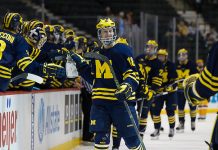One final point on my last post before we begin: I said no more blogging when I was sick, and that’s probably a good move. Of course, the truth is I don’t think that’s why I forgot in my last post that Cam Atkinson was the sixth member of the Mean Street Posse (apologies to those who didn’t get that joke, but the people who did are probably loving it).
I had completely forgotten that Cam had been arrested before his BC career started, and I assumed that if there were some sort of major disciplinary issue that affected his candidacy, I would have heard about it in the last few months. Of course, we all know what happens when one assumes: it makes an “ass” out of “u” and “me.” Of course, I can only speak for myself, and certainly not the more rude among those who left the 47 comments, but I certainly did feel quite sheepish when that oversight was pointed out. I apologize.
But we’re getting away from the point. This has been a two-horse race between Miele and Frattin for a good little while now, and as I continue to compare them, I’m going to leave Atkinson out of it. If it turns out on Friday that I’m wrong to do so, I will willingly eat all the crow BC fans wish to feed me while I try to figure out how Atkinson won the Hobey where Nathan Gerbe, Patrick Eaves, and Brian Gionta (among others) did not.
So, moving along, we’re going to look at that whole debate that started after our pals over at Inside College Hockey crunched some numbers and determined that Frattin had done a lot of his damage this season against the bottom half of the WCHA, where Miele was much stronger than Frattin against the top half of their respective conferences. While Miele’s supporters point to this as evidence that Miele is more deserving of the award, Frattin’s supporters argue – not without a point, mind you – that the WCHA is a stronger conference top to bottom, with more Teams Under Consideration, and it’s not as if Frattin is beating up on bad teams.
Personally, I feel there’s be a limit on how much strength of schedule and conference strength should be considered when an individual award is on the line. It reminds me of one of the things I hate most about the BCS in football: the idea that scheduling decisions made years beforehand can wind up affecting how voters consider two players’ achievements. I believe that you play the hand you’re dealt, and you make the most of it. Now, does that mean Paul Zanette’s goals should be weighed equally against Matt Frattin? No. As much as I like Atlantic Hockey, I don’t think anyone will argue that the conference doesn’t have the top-to-bottom strength of other conferences in the country, even though the Atlantic Hockey champion has shown itself to be a darn good team, year in and year out, in the NCAA tournament. I think that if Miele played better in the toughest games on his schedule than Frattin did in the toughest games on his schedule, that’s worth considering.
Still, I did a little numbers work of my own, and came up with what I think is a fair means of comparing the two players: points against teams that competed in this year’s NCAA tournament. This cuts out any debate over whether the seventh, eighth or ninth place team in the WCHA is as good as a team in the top half of the CCHA and just gets to the teams that were selected for this year’s tournament.
During the course of the season, Andy Miele played three games against New Hampshire, five games against Western Michigan, five games against Notre Dame and two games against Michigan. In those games, Miele had eight goals and 17 assists, a total of 25 points in 15 games. Meanwhile, so far this season, Matt Frattin has played four games against Denver, three games against Minnesota Duluth, four games against Nebraska-Omaha, two games against Notre Dame, three games against Colorado College and a game against Rensselaer. In those games, he has nine goals and six assists, a total of 15 points in 17 games.
(And if you’re one of those people who thinks that the NCAA’s selection process s awful and you think KRACH should be the method for selecting the field, the only change that would have been made this year is Minnesota for RPI. Recalculate with no goals and an assist in two games against the Gophers instead of a goal and an assist in one game against RPI, and you get eight goals and six assists in 18 games.)
Personally, I think Frattin has had a tremendous season, and had a heck of a Hobey Baker Moment when he scored the game-winning goal against Denver in the WCHA title game. On the whole, though, if you’re talking about scoring against the best teams on the schedule, Miele does, in fact, have an edge.
Update, 9:20 a.m. After being called on the carpet by a commenter who had a point, I decided to include the stats against tournament teams for Cam Atkinson. This season, Atkinson played two games against Denver, one against Notre Dame, four against Merrimack, three against New Hampshire and one against Colorado College. In those 11 games, Atkinson had 12 goals and seven assists, which makes for a favorable comparison with the other two players. I don’t think, however, that it’s enough to put him past the nation’s overall leading scorer or the nation’s top goal-scorer in the eyes of the Hobey voters. I suppose I could be wrong, however…it’s certainly happened enough.


